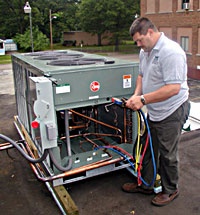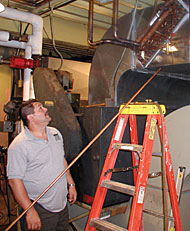The unique architectural elements, high ceilings, and varying occupancy demands of churches can pose interesting challenges for HVACR contractors, whose job it is to market products and services to church leaders and correctly size and install the heating and cooling equipment in each building.
Some of these issues were addressed during a recent discussion on "The Wall," an Internet discussion board at www.heatinghelp.com.
The News joined in the discussion and discovered some tips on sizing church jobs and marketing to church organizations, tasks often undertaken by both residential and commercial contractors.

Sizing The Job
The message on The Wall that initiated the discussion read in part: "I have been asked to quote replacement boilers in several area churches. Most of them have huge boilers that are fuel inefficient and probably grossly oversized, but I need to know for certain that they are. I am at a loss as to how I should calculate the heating load in cathedral-type buildings with vast expanses of stained glass windows, and unknown insulation values of the structure." (For more details about this application, see the sidebar "How Would You Size The Job?" below.)One contractor, Dave Bunnell of Boiler Professionals, Amboy, Ill., replied, "As with any larger structure, infiltration can only occur near outside walls, so I assume only the outer 15 feet of the structure as basis for the air changes per hour calculation. Also, when figuring infiltration air changes per hour, most sanctuary structures are much more airtight than the typical structure. The ceiling is a continuous, nearly airtight sheet of plaster." He noted typical structures have many partitions breaking the airtight surface of the ceiling, pointing out that there are few or no interruptions in most churches, so less air leaks at the ceiling. "Little air leakage at the top means much less air coming in at the base due to a reduced stack effect through the space," he said.
Bunnell noted that it is important to take church windows into consideration, figuring the R-value of windows about "halfway between single-pane and double-pane glass, due to the fact that the air layer between the windows is probably not very stable due to the leaky nature of old leaded glass windows with brittle caning."
Dan Holohan, founder of The Wall, suggested, "If it's steam heated, you may find that the output of the installed boiler and radiation are much less than the actual heat loss of the church. The undersized radiators would provide radiation, and also convective currents that didn't rise all the way to the ceiling.
"The air near the top of the church stayed cool all the time. When you add ceiling fans to these buildings, you actually increase the fuel usage during the winter because the fans stir the cooler air into the lower, heated air, causing the overall air temperature to stay below the thermostat's setting. That's why you don't often see those fans running during the winter."

Marketing To Churches
The Newsasked its Contractor Consultants about the unique aspects of church installations and the special steps necessary when marketing to church organizations."The churches with which we work are the result of satisfied customers, mostly commercial, that appreciate the work we do for them at their places of business," said Aaron York (Aaron York's Quality A/C, Indianapolis). "They become disenchanted with member repairs by those who ‘are in the business' when comfort levels and supposedly ‘free' costs become an embarrassment to them.
"They also find that the expected savings of such hit-or-miss maintenance flow down the drain of delayed attention, resulting in major expense. When such work is done on a time and material basis, we discount their repair billings by 10 percent.
"We have some churches that have seen the wisdom of placing their HVACR equipment under a full service contract where we become responsible for all materials, labor, maintenance inspections, filter changes, emergency calls, etc., for one budgeted monthly fee, which they plug into their annual budgeting, keeping everyone happy.
"The occasional necessary replacement, which is fewer than with ‘call when it breaks,' seems to be well accepted."
Russ Donnici (Mechanical Air Service, San Jose, Calif.) has a unique approach. "Our church work is primarily through referrals. However, the nonprofit, tax-exempt company I started in 1995, Outreach Heating & Cooling, does get referrals to churches that have budget issues. We have provided free services and reduced cost services, as well as free consulting work when needed.
"I currently serve on the elder board of the church I have attended for the past 23 years, and we just approved a substantial upgrade replacement to our sanctuary system for sound-related and age issues. This was a concern for a long time, and when the unit was determined to need replacement, the upgrade was submitted."

The Power Of Referrals
"We have added several churches to our customer list over the past few years without any marketing plan at all," said Ann Kahn (Kahn Mechanical, Dallas). "Eight years ago, a large church contacted us, as they were taking quotes on their preventive maintenance service, and we were the successful bidder. Apparently, we have met their needs well, for they have recommended us to other churches, and the rest is history."We find church committees in charge of HVAC especially sensitive to the need for maintenance. Church clients choose our regular preventive maintenance service when they don't have their own staff person for the work."
Scott Getzschman (Getzschman Heating & Sheet Metal, Fremont, Neb.), noted, "The work we do for churches is usually word of mouth, and we do have churches with maintenance agreements. They can be very difficult, since with churches the property committees change often, so you can sometimes lose the work because you don't have a relationship with the new committee chairman. Church work can be very competitive, and you have to please many people.
"Our experience in smaller churches is, typically, if the systems aren't on a contract, they only get serviced if they fail. In larger churches, systems are usually on agreement; however, in the months between visits, the systems don't always get taken care of."
"Residential companies should seek expert advice before putting their reputation in front of the membership because you may now have hundreds of parishioners judging you weekly," cautioned Dave Dombrowski (Metro Services/ARS-ServiceMaster, Raleigh, N.C.).
"Church relationships must be built upon mutual trust, and respect is the key factor in dealing with the needs of the church."

Sidebar: Being A Familiar Face Helps Get Church Business
MUSKEGON, Mich. - When Don Bowen bids on church building HVAC service and replacement business, he can point to a binder full of recommendations and compliments from other churches."You get one or two and do a good job and away you go," said the owner of Bowen Refrigeration, Heating & Cooling in Muskegon. "Always get reference letters, too."
He also likes to get involved with each job by "doing his homework."
"I got one job because no one else would do it," he said. "The customer asked me how I could install A/C when no one else would do it. I told them I could install a custom-built coil and add air conditioning to it - no problem. And they have had no problems with their A/C."
On the day of a recent News visit, Bowen was in the middle of installing A/C in another church that other contractors said posed insurmountable problems. "I had bid the office area of this church in prior years," he said. "The maintenance person called us and said the church was interested in air conditioning the whole church. It provided a lot of unique problems, starting with tracking down the company that originally did the installation."
The air handler was installed in 1956. Don asked his wife and office manager, Jennifer, to see if she could track down information on the company that made the equipment. Using the Internet, she was able to find who took over the company after it was sold. The company gave her the number of the engineer who actually worked on the installation, and he sent Don the original paperwork, which was obtained from microfiche.
"I measured airflow to get ideas on what this air handler could handle. I figured how much airflow that unit could handle and how much cooling I could put on the equipment. We had a 2-ton, dual-circuited custom evaporator coil built, and it was piped to a 20-ton condenser on the roof. Coil Replacement Specialists (Okemos, Mich.) built the coil. They came out and took measurements and specifications. They did a great job; the coil was built in 10 days.
"We removed the existing trunk, built a new elbow, and installed the coil into the ductwork, which matches the ductwork. This is 20 tons of air conditioning in two 10-ton circuits.
"The original building was only a third of the size it is now. If you put your time into it, research it, and put all of your ducks in a row, you can make things happen. I had to size this job according to what I had to work with. If I hadn't gotten ahold of the original engineer, I probably would not have done the job. I could have recommended a replacement air-handling unit, but it may have been too much guesswork, which creates a lot of problems."
"I was able to do something else that no one else would do."
Sidebar: How Would You Size The Job?
[Editor's note: One visitor to The Wall, an online forum at www.heatinghelp.com, faced a challenging job: specifying replacement boilers for a cathedral-style church with stained glass windows. The following information is reprinted with permission from The Wall. What advice would you give if you had to size this job? E-mail your thoughts to John Hall at johnhall@achrnews.com.]The church is a 60-year-old brick-faced building that is 175 feet long, 80 feet wide, and 54 feet high. The exterior walls consist of two courses of interlocking bricks at the core, with a brick facing added to the exterior and glazed tile brick on the interior. The interior tile extends 6 feet up the wall, and from there it becomes plaster finish to the ceiling line. The ceiling itself is tongue and grooved 2-1/2-inch planks, with a slate covering on the exterior. No other details of the roof are available.
There is a separate 150-ton cooling system serving six air handlers. The church members are adamant about not heating with forced air because of noise issues (older priests, soft voices, no amplifier systems).
All three entry doors to the sanctuary have airlock-type vestibules and are sizable areas unto themselves.
The biggest complaints registered over the years have been that the sunny side of the church overheated while the shaded side was always too cold.
All the nomenclature from the existing boiler has been removed over the years, so knowing what is currently there is at best a ‘guesstimate' (somewhere around 2 million Btu, based on burner sizing).
The building has a full finished basement, which is used as a fellowship hall that is 60 percent earth embanked, but with two walkout entries to the ground-level parking lot areas.
There is no existing mechanical air ventilation system. The building had been heated for 60 years with a steel pipe in concrete radiant system. The steel piping has finally rotted and the custodian kept feeding water to the boilers daily to try and maintain heat all of last winter. Well, that destroyed the boilers in short order.
The windows are huge - 10 feet wide by 30 feet high ending in arched tops; and are of single-pane stained glass. There is no exterior protective covering to act as a possible air space. I have suggested adding a protective covering, but they have concerns about the appearance.
At peak times, there are 800 people in the building; at other times, as few as 150.
Publication date: 08/16/2004

Report Abusive Comment